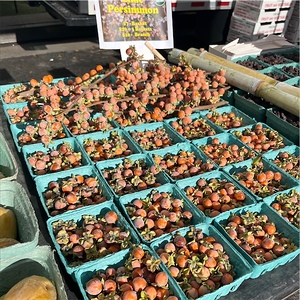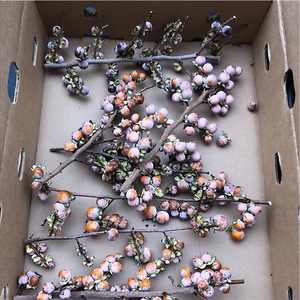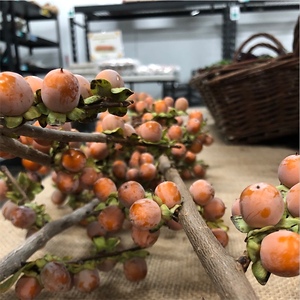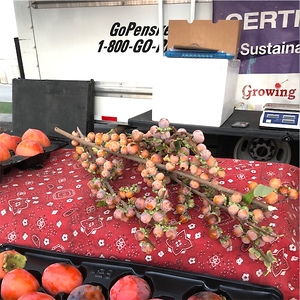


Lilac Persimmons
Estimated Inventory, ea : 0
Description/Taste
Lilac persimmons are small fruits, averaging 1 to 2 centimeters in diameter, and have a round to oval shape. The skin is smooth, taut, and glossy, initially green when young, ripening to orange-yellow or to a purple, almost brown hue with maturity, depending on the variety. The skin is also thin, easily bruised and discolored, and is covered in a powdery, white-grey bloom. Underneath the surface, the flesh is dense, semi-aqueous, soft, and orange or purple, encasing 1 to 2 hard seeds or found seedless. Lilac persimmon trees are known for emitting a musky, honeyed scent when ripe, and the optimal time to consume the fruit is when the flesh becomes soft and slightly squishy. It is important to note that the fruits are astringent with a dry mouthfeel when firm and should only be consumed once the natural sugars have been established. Ripe Lilac persimmons have a sweet, sugary flavor with subtle fruity notes of plums and oranges. When dried, the flesh develops a date-like consistency with a rich, syrupy, and toffee-like taste.
Seasons/Availability
Lilac persimmons are available in the fall through winter.
Current Facts
Lilac persimmons, botanically classified as Diospyros lotus, are fruits that grow in small clusters along branches of deciduous trees belonging to the Ebenaceae family. The ancient fruits are native to regions spanning across Europe and Asia, growing wild along roadsides, forest edges, and hillsides, and are believed to be one of the oldest cultivated fruits in existence. There are many different wild varieties of Lilac persimmons with two main types found in cultivation, one with orange skin at maturity and one with purple skin, but regardless of the skin color, the fruits contain a similar, sweet flavor. Lilac persimmons are also known by many regional names, including Caucasian persimmon, Amlock, Khormaloo, and Date Plum, a popular descriptor used to highlight the fruit’s sugary date-like taste mixed with the brightness and fruitiness of a plum. Throughout its native region, Lilac persimmons are frequently planted in home gardens, villages, and town squares as an edible landscape cultivar. The variety is also considered highly ornamental, bearing hundreds of small fruits on branches into the winter season, and the fruits are traditionally picked after the first few frosts, which helps to concentrate sugars within the flesh for fresh and dried uses.
Nutritional Value
Lilac persimmons are a good source of vitamins A and C, antioxidants that protect the body again free radical damage, reduce inflammation, and strengthen the immune system. The fruits also contain fiber to regulate the digestive tract and lower amounts of copper, vitamin K, potassium, and manganese. In Asian folk medicines, Lilac persimmons are believed to reduce symptoms associated with lung infections, stress, fever, and hiccups. They are also seen as a cooling ingredient to cleanse the body.
Applications
Lilac persimmons are best suited for fresh or dried applications and should be eaten when overly ripe, bearing a soft consistency. The fruits can be tossed into salads, used as a topping over grain bowls, oatmeal, and porridge, or blended and swirled as flavoring into ice cream. Lilac persimmons can also be cooked into jams, jellies, and sauces, or smashed, cooked, and dried into fruit leather. When the fruits are dried, they develop a sticky and chewy, date-like consistency and can be mixed into baked goods, including cakes, pies, and bread. The dried fruits can also be used on salads or combined with other ingredients for trail mixes and granola. Lilac persimmons pair well with other fruits such as pears, grapes, coconut, peaches, cherries, and pomegranates, vanilla, chocolate, honey, brown sugar, and spices such as nutmeg, cloves, cinnamon, allspice, and anise. Whole, unwashed Lilac persimmons should be stored at room temperature and will keep for a couple of weeks, depending on the degree of ripeness.
Ethnic/Cultural Info
Lilac persimmons are known as the “god of fruits” in Greece for their sugary-sweet, favorable flavor. In ancient times, the aromatic fruits were believed to have been sent from the heavens, and many Greeks thought it was a favorite fruit of Zeus. Over time, the fruit’s “heavenly” reputation earned the variety its botanical name Diospyros, meaning “divine fruit” or “wheat of Zeus.” Experts also believe Lilac persimmons were mentioned in Homer’s epic poem The Odyssey. In the story, there was a honey-sweet fruit that caused the men to forget their past and future, becoming enamored with only eating the fruits of the land of lotus.
Geography/History
Lilac persimmons have an extensive native range, spanning from Southwestern Asia across Central Asia into Iran, Turkey, Pakistan, Afghanistan, and Southern Europe. The fruits have been cultivated since ancient times and are found in subtropical to temperate climates. They were also brought to England and Northeastern Europe around 1597 BCE. Today Lilac persimmons are widely cultivated and still found growing wild in their native range, and the fruits have also been introduced to areas of North America, North Africa, and Australia.
Recipe Ideas
Recipes that include Lilac Persimmons. One
| What's Gaby Cooking |
|
Persimmon Caprese Salad |
| Wholefully |
|
Bourbon Persimmon Bread |

















